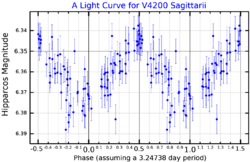Astronomy:HR 7578
| Observation data Equinox J2000.0]] (ICRS) | |
|---|---|
| Constellation | Sagittarius |
| Right ascension | 19h 54m 17.17.7453s[2] |
| Declination | −23° 56′ 27.8630″[2] |
| Apparent magnitude (V) | 6.18[3] |
| Characteristics | |
| Spectral type | K3 V + K3 V[4] |
| U−B color index | +0.915[5] |
| B−V color index | +1.045[5] |
| Variable type | BY Dra[3] |
| Astrometry | |
| Radial velocity (Rv) | −5.1 ± 0.2[6] km/s |
| Proper motion (μ) | RA: −124.476±0.067[2] mas/yr Dec.: −410.440±0.043[2] mas/yr |
| Parallax (π) | 70.8873 ± 0.0399[2] mas |
| Distance | 46.01 ± 0.03 ly (14.107 ± 0.008 pc) |
| Orbit[7] | |
| Primary | HR 7578A |
| Companion | HR 7578B |
| Period (P) | 46.816103±0.000057 d |
| Eccentricity (e) | 0.68640±0.00028 |
| Periastron epoch (T) | 2455441.0477±0.0030 HJD |
| Argument of periastron (ω) (secondary) | 241.168±0.046° |
| Semi-amplitude (K1) (primary) | 47.84±0.033 km/s |
| Semi-amplitude (K2) (secondary) | 48.686±0.031 km/s |
| Details | |
| Rotational velocity (v sin i) | 2.0[4] km/s |
| Other designations | |
| Database references | |
| SIMBAD | data |
| ARICNS | data |
HR 7578 (also known as V4200 Sagittarii) is a binary star in the constellation of Sagittarius. Their combined apparent magnitude is 6.18.[3] Parallax measurements by the Gaia spacecraft put the system at 46.01 light-years (14.107 parsecs) away, making this a nearby system.[2]
The two stars of HR 7578 are fairly old, older than the Pleiades but possibly younger than the Hyades.[6] The stars are between 5×108 and 2×109 years old.[6] Both are K-type main-sequence stars.[4] Both stars have a minimum mass of 0.85 ± 0.03 M☉, and are unusually metal-rich, showing high amounts of cyanide and sodium in their spectra.[6]
HR 7578 is a BY Draconis variable. This is a class of variable star whose variability comes from starspots on the stars' surfaces. HR 7578 also has a common proper motion companion, 2MASS J19542064−2356398. It is a red dwarf that is at least 580 astronomical units from the central star system.[3]
References
- ↑ "Light Curve". ESA. https://www.cosmos.esa.int/web/hipparcos/java-tools/light-curve.
- ↑ 2.0 2.1 2.2 2.3 2.4 2.5 Brown, A. G. A. (August 2018). "Gaia Data Release 2: Summary of the contents and survey properties". Astronomy & Astrophysics 616: A1. doi:10.1051/0004-6361/201833051. Bibcode: 2018A&A...616A...1G. Gaia DR2 record for this source at VizieR.
- ↑ 3.0 3.1 3.2 3.3 Chini, R.; Fuhrmann, K.; Barr, A.; Pozo, F.; Westhues, C.; Hodapp, K. (2014). "New visual companions of solar-type stars within 25 pc". Monthly Notices of the Royal Astronomical Society 437 (1): 879–886. doi:10.1093/mnras/stt1953. Bibcode: 2014MNRAS.437..879C.
- ↑ 4.0 4.1 4.2 Pasquini, L.; Cortés, C.; Lombardi, M.; Monaco, L.; Leão, I. C.; Delabre, B. (2015). "Tachoastrometry: Astrometry with radial velocities". Astronomy & Astrophysics 574: A76. doi:10.1051/0004-6361/201424882. Bibcode: 2015A&A...574A..76P.
- ↑ 5.0 5.1 Mermilliod, J.-C. (1986). "Compilation of Eggen's UBV data, transformed to UBV (unpublished)". Catalogue of Eggen's UBV Data. Bibcode: 1986EgUBV........0M.
- ↑ 6.0 6.1 6.2 6.3 Fekel, F. C. Jr.; Beavers, W. I. (1983). "HR 7578 - A K dwarf double-lined spectroscopic binary with peculiar abundances". The Astrophysical Journal 267: 682. doi:10.1086/160905. Bibcode: 1983ApJ...267..682F.
- ↑ Fekel, Francis C.; Henry, Gregory W.; Tomkin, Jocelyn (2017). "New Precision Orbits of Bright Double-lined Spectroscopic Binaries. X. HD 96511, HR 7578, and KZ Andromedae". The Astronomical Journal 154 (3): 120. doi:10.3847/1538-3881/aa816e. Bibcode: 2017AJ....154..120F.
 |


